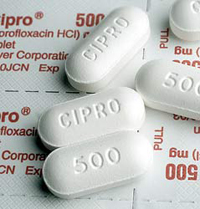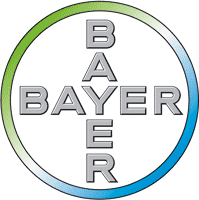By Kevin E. Noonan —
The Federal Circuit today issued its decision in the
Ciprofloxacin antitrust litigation, in an opinion that addressed the extent to
which a patent-holding innovator drug company can enter into an agreement with
a generic competitor that keeps the generic drug off the market.

Bayer holds U.S. Patent No. 4,670,444 claiming
generically certain antibiotic drugs, and specifically ciprofloxacin
hydrochloride that Bayer sells as Cipro®. Barr filed an Abbreviated New Drug Application (ANDA) containing a
Paragraph IV certification that the '444 patent was invalid and
unenforceable. During the course
of the ensuing litigation, the other named defendants became involved through
agreements with Barr. Before trial,
Bayer and Barr settled the litigation, with the various parties entering into
several agreements. These
agreements provided that none of the defendants would challenge the validity or
enforceability of the '444 patent, and that Barr would convert its Paragraph IV
certification to a Paragraph III and not market its generic Cipro® until the '444
patent expired.
The most significant provision of these agreements
provided that Bayer would sell Cipro® to Barr for resale or make quarterly
payments ("reverse payments") until December 31, 2003. In return, Barr agreed not to sell a
generic version of Cipro® until at least six months before the '444 patent
expired. In a footnote, the Court
noted that Bayer had paid Barr a total of $398 million under this agreement.

After entering into these settlement agreements, Bayer
filed for re-exam, and although some claims were amended or cancelled, the
claim to the Cipro® drug product was not changed. Thereafter, four other generic drug companies (Schein,
Mylan, Carlsbad, and Ranbaxy) filed ANDAs on the re-examined '444 patent. Bayer prevailed over Schein and Mylan
on summary judgment, and won a bench trial against Carlsbad. (Ranbaxy's suit was dismissed when it
withdrew its Paragraph IV certification.) Inequitable conduct was not raised
in any of these actions.
The underlying District Court litigation was a
consolidation of several antitrust actions by patient advocacy groups and both
direct and indirect Cipro® purchasers. In this suit, the plaintiffs raised four counts under Federal antitrust
law, as well as a fifth count under state antitrust and consumer protection
laws; these state law claims were based on the allegation that the '444 patent
was obtained through fraud on the Patent Office and the actions were sham
litigations. The District Court
granted summary judgment for Bayer on the antitrust counts, and dismissed the
state law claims as being barred by preemption. This decision was based on the District Court's
determination that all of the misconduct alleged involved misconduct before the
PTO (as opposed to misconduct in the marketplace, for example).

The Federal Circuit affirmed, in an opinion by Judge
Prost joined by Judge Schall and Judge Ward of the Eastern District of Texas,
sitting by designation. The plaintiffs
made the following allegations of error by the District Court that were
addressed in Judge Prost's opinion:
(1) that the Agreements were per se unlawful, or were
unlawful under a properly-applied rule of reason analysis;
(2) that the Agreements did not fall within the
"exclusionary zone" of the '444 patent;
(3) that the district court did not consider the law of
the regional circuits and government agencies in evaluating the Agreements;
(4) that the district court did not appreciate the
(negative) effects of the Agreements on other generic manufacturers; and
(5) that the district court did not consider evidence
showing that the Agreements preserved Barr's claim to the 180-day exclusivity
period.
The CAFC began its analysis by reminding the plaintiffs that
the Supreme Court had interpreted the Sherman Act's prohibition on restraint of
trade to include only unreasonable restraints, and that this was the proper
context for assessing whether the Agreements were per se illegal or illegal
under a rule of reason. In order
for these Agreements to be per se illegal under the Sherman Act, they would
need to have a "predictable and pernicious anticompetitive effect,
and . . . limited potential for procompetitive benefit." The Federal Circuit said the District Court
had "no basis" for finding such a predictably anticompetitive effect,
and thus properly applied a rule of reason approach. Using Second Circuit law, the CAFC set out a three-step
process for applying the rule of reason:
First, the plaintiff bears the initial burden of showing
that the challenged action has had an actual adverse effect on competition as a
whole in the relevant market. Then, if the plaintiff succeeds, the burden
shifts to the defendant to establish the pro-competitive redeeming virtues of
the action. Should the defendant carry this burden, the plaintiff must then
show that the same pro-competitive effect could be achieved through an
alternative means that is less restrictive of competition.
The District Court, applying these rubrics, found that the relevant market was
ciprofloxacin and that Bayer had market power in that market. However, the District Court also found
that there was "no evidence that the Agreements created a bottleneck on
challenges to the '444 patent or otherwise restrained competition outside the
'exclusionary zone' of the patent." Under these circumstances the District Court found, and the Federal
Circuit affirmed, that the plaintiffs had not established the first prong of
the test, that there was an anticompetitive effect of the Agreements.
The opinion addressed the plaintiffs' further contention
that the Agreements represented an abuse of the patent right, by using the
patents to insulate Bayer from competition and avoid the risk of having the
'444 patent invalidated. "[A]
patent by its very nature is anticompetitive," according to Judge Prost's
opinion, constituting "'an exception to the general rule against
monopolies and to the right of access to a free and open market.'" The District Court
properly recognized "this underlying tension between the antitrust laws
and the patent laws," according to the Federal Circuit, and further recognized that
"any adverse anti-competitive effects within the scope of the '444 patent
could not be addressed by antitrust law," citing Supreme Court and several
regional circuit court of appeals opinions for this proposition.
Judge Prost's opinion also cited the "long-standing
policy" in favor of settlements, including in patent litigation, and that
preventing a competitor from entering the market, and using a patent to do so,
was within the patentee's right to exclude. Nor were the provisions in the agreement that Barr and the
other generic company defendants would not challenge the validity or
enforceability of the '444 patent sufficient to raise antitrust liability,
according to the Federal Circuit. These are common provisions in patent litigation settlement agreements,
and the record showed that four other generic companies filed ANDA's with
Paragraph IV certifications, illustrating that the Agreements did not prevent
the validity or enforceability of the '444 patent from being challenged.
The opinion then turned to the allegation that the District Court should have considered the legal standards used by the various
regional circuit courts of appeal and by government agencies such as the
Federal Trade Commission in assessing antitrust liability for such exclusionary
agreements under Hatch-Waxman. Most significantly, the CAFC distinguished the Agreements and the
conduct of the parties in this case with those in the In re Cardiezem CD Antitrust
Litigation. These distinctions
included that the Agreement in the Cardiezem case involved restrictions on
sales of non-infringing versions of the generic drug, and an agreement whereby
the generic manufacturer did not relinquish its 180-day exclusivity period,
thus creating a real impediment and delay in the ability of other generic
manufacturers from entering the marketplace. These provisions created anticompetitive effects outside the
exclusion zone of the patent in that case, which were not features of the
Agreements at issue here. Moreover, the opinion voiced its agreement with the Second Circuit (In
re Tamoxifen) and Eleventh Circuit (In re Schering-Plough) that a court need
not consider the validity of a patent underlying an ANDA settlement agreement
unless there is evidence of inequitable conduct or sham litigation. The CAFC agreed with Judge Posner (in Asahi Glass Co. v. Pentech Pharms., Inc., 289 F. Supp. 2d 986 (N.D. Ill. 2003)) that
"if 'there is nothing suspicious about the circumstances of a patent
settlement, then to prevent a cloud from being cast over the settlement process
a third party should not be permitted to haul the parties to the settlement
over the hot coals of antitrust litigation.'"
The Federal Circuit also rejected the plaintiffs' contention that
antitrust liability arose under the Agreements because they had the effect of
delaying challenges by other generic drug manufacturers, in view of the
evidence that there was no "bottleneck" that inhibited other generic
manufacturers from filing ANDAs in the face of these Agreements. The Court also rejected the contention
that the Agreements were unlawful because Barr retained its claim to the
180-day exclusivity period. The Court
noted that these Agreements were in effect prior to amendments to the
Hatch-Waxman Act that removed the requirement that a first ANDA filer must
"successfully defend" the patent infringement suit brought by the
patent holder under the Hatch-Waxman regime. Accordingly, Barr did not retain the right to the 180-day
exclusivity period because it settled rather than prevailed in its lawsuit with
Bayer, something the Court noted Barr acknowledged in the consent judgment that
concluded its ANDA litigation with Bayer as part of the settlement agreement.
The Federal Circuit also affirmed dismissal of Count V of
plaintiffs' complaint, based on state antitrust law, under the doctrine of
federal preemption. The Court
agreed with the District Court that any misconduct alleged by plaintiffs in
support of this claim was misconduct that occurred before the Patent Office,
and that the issue was one of patent law which fell exclusively under federal
law.
This case illustrates once again the "tension,"
even in a legal scheme as comprehensive as Hatch-Waxman, between the
exclusivity arising under patent law and its counter prohibitions on restraint
of free competition under antitrust law. The Federal Circuit's decision here clarifies the types of behavior that
fall within the protections of patent law and those that do not and thus raise
antitrust liability.
In re Ciprofloxacin Hydrochloride Antitrust Litigation (Fed. Cir. 2008)
Panel: Circuit Judges Schall and Prost and District Court Judge Ward
Opinion by Circuit Judge Prost

Leave a comment